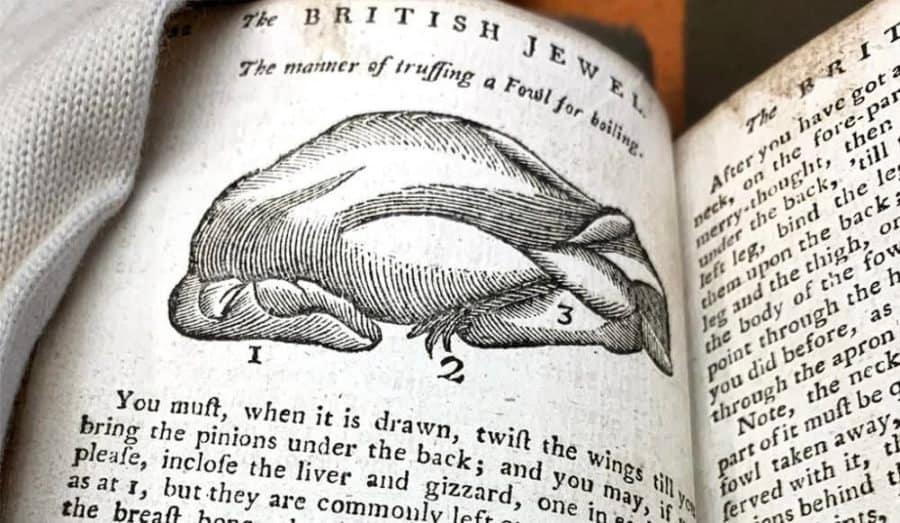With Thanksgiving nearly upon us, casual cooks across the country are getting ready. Gone are the days when one could simply throw a turkey into the oven and wait for the plastic timer to pop. Cooking Thanksgiving dinner has become a taxing, high-stakes enterprise.
In 2019, a proper turkey must — at minimum — be submerged for 24 hours in salty-sweet brine to safeguard guests from dry breast meat, the ultimate culinary failure. Ambitious cooks will deep-fry their (brined) turkeys in a cauldron of scalding oil — adding a bracing element of danger to the holiday meal — or they’ll smoke them over hickory chips on the backyard grill. While crispy, golden skin remains the hallmark of a perfectly cooked turkey, today’s cutting-edge birds often feature fancy glazes made of cider, citrus, coffee, curry, etc.
Don’t want to bother with brines, barbecues, glazes, or boiling oil? Consider turning back the clock to simpler times when dining occurred over candlelight, ovens were wood fired, and it was a safe bet that nobody around the table had recently bathed. That’s right: Transport your friends and family to the 18th century for a truly memorable Thanksgiving feast. Yale’s Beinecke Rare Book & Manuscript Library has resources to guide your gastronomic time travel.

“The Beinecke Library houses one of the world’s largest and most dynamic collections of rare books and manuscripts, including many historic and culturally significant cookbooks, and we’ve been delighted by how faculty use these resources in teaching,” said E.C. Schroeder, the library’s executive director. “Diligent researchers doubtlessly will also discover any number of intriguing recipes on which to base a crowd-pleasing holiday meal.”
In the library’s collections you’ll find “The New British Jewel or Complete Housewife’s Best Companion,” a slender volume from 1785 that offers “a choice variety of useful family receipts [recipes],” plus gardening tips, home remedies, and, helpfully, “a method of restoring to life people drowned, or in any other manner suffocated.”
The British Jewel contains a turkey recipe unlikely to appear in the pages of Food & Wine or Bon Appétit — one that involves stuffing the bird with shredded sweetbreads (aka: pancreas) of veal and boiling it in milk and water.
Not into boiled turkey or sweetbreads? Shift gears and choose one of the British Jewel’s enticing recipes for roasted or stewed partridge, pigeon, or hare.
The old cookbook offers a recipe for seafood-based appetizers that will make shrimp cocktail seem duller than ever. Tempt your guests with a tray of pickled eels or a “ragoo of oysters” topped with a relish of breadcrumbs, parsley, chives, and oyster liquor — the briny liquid inside the shell. Put a nutty twist on Thanksgiving condiments by swapping tired cranberry sauce for a vibrant “walnut catchup,” made via a complex recipe that begins with mashing green walnuts into a paste and mixing them with vinegar at a ratio of two quarts per every 100 nuts.

Rich and savory gravy is key to a successful turkey (or hare) dinner, so you’ll not want to miss the recipe for a “sauce for chickens” that could grace The New York Times’ food section. A spoonful of “oyster pickle” lends the gravy a salty pop.
Stoke holiday cheer and induce caustic political arguments with an eclectic selection of homemade libations, including gooseberry, birch, and turnip wines. (Turnip wine requires three months, “a good many turnips,” and enough brandy to inebriate a hippo.)
No holiday dinner is complete without dessert, and the British Jewel offers a lavish array of confections sure to enchant your party’s sweetest sweet tooth, including cheesecake, jellies, custards, and “a quaking pudding with almonds.”
Should you or your guests suffer post-feast indigestion, consult the book’s medicinal recipes for “a never-failing cure for the hic-cough” and a “simple bitter infusion for a cold weak stomach.” (“Cures” for asthma, “the itch,” and the “bite of a mad dog” are also provided.)
Cautionary note: The instructions for reviving a drowned/suffocated person primarily involve laying the distressed individual by the fire and nursing them with wines and spirits. If one of your guests happens to choke on a pickled eel, it’s best to instead apply the Heimlich maneuver and, if need be, call an ambulance.
Provided no suffocations spoil the holiday cheer, you can retire to the parlor after dinner, a last glass of turnip wine in hand, to enjoy a nap beside a roaring fire.
Happy Thanksgiving!

